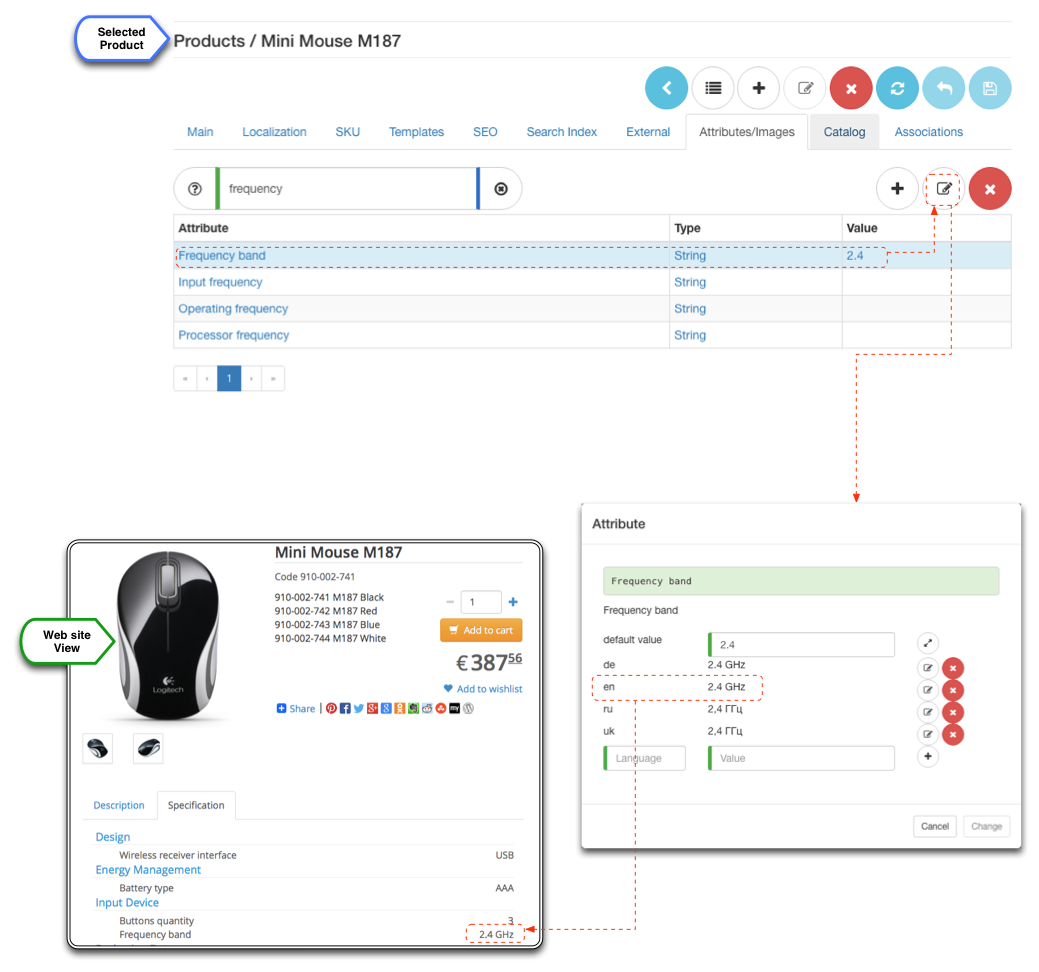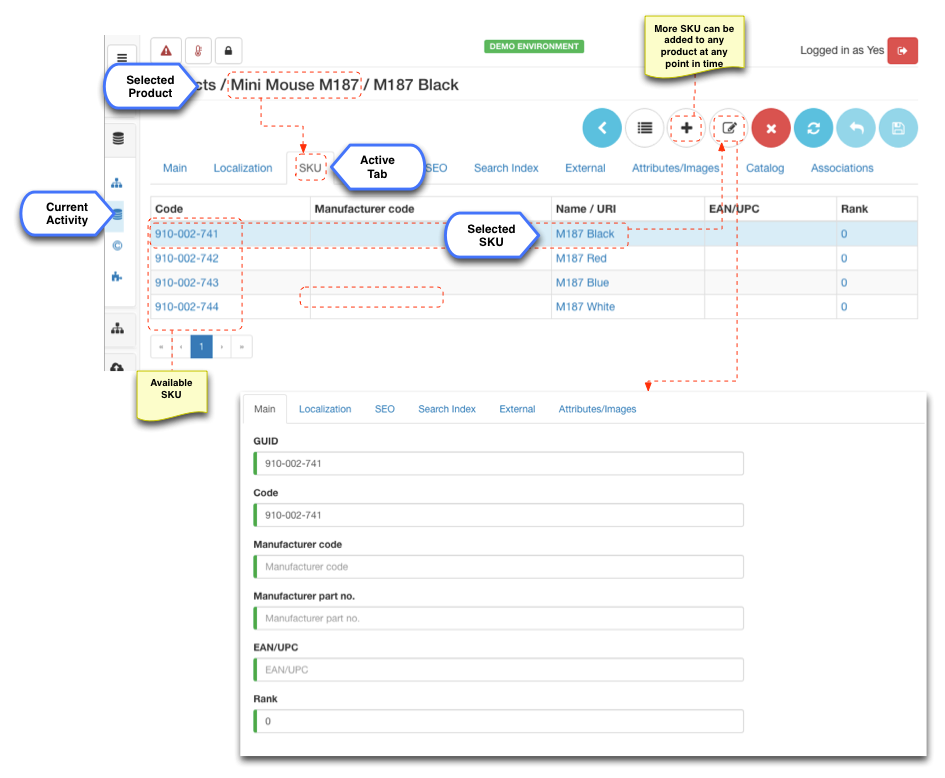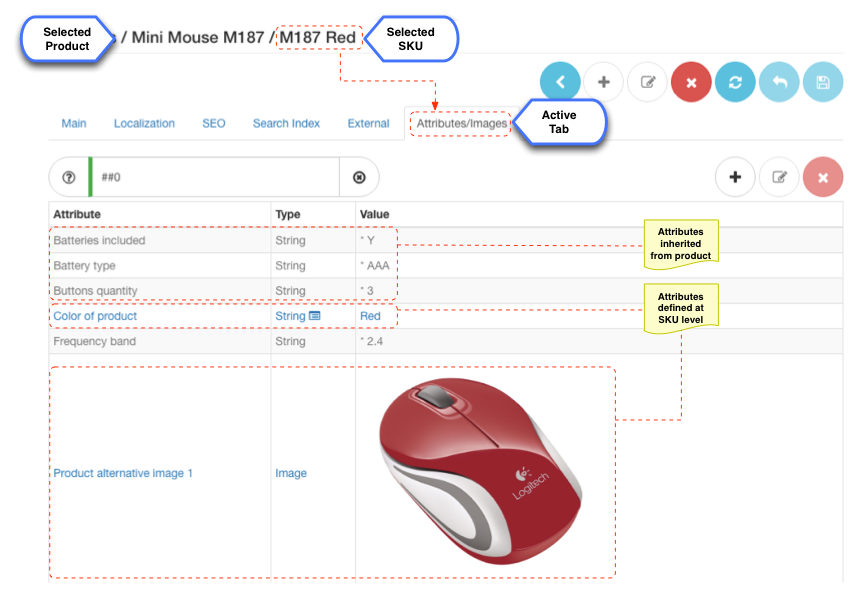...
Product core information is contained in several tabs. GUID and code are unique identifiers for the product across the whole platform they are used for bulk import. It is anticipated that code contains a human readable value (e.g. base SKU code or variation thereof) whereas GUID is auto generated. However it is possible to have the same values for code and GUID. Product code is also used to resolve product images during image import.
...
Brand is used for brand navigation. List of available brands can be updated via brands management section.
| Tip |
|---|
| Brand is automatically exposed by the platform as "brand" navigatable attribute which can be used in product type configurations thus making it a configurable data attribute. |
...
All search links are SEO friendly and can be used for many different purposes such as creating group of products related to a promotion, combining products into collection or a bundle, provide recommendations etc. All is needed is to add one or more tags (words separated by space) and then tag links can be embedded into CMS components or pages to give customer direct access to these lists (as done on demo store top navigation menu item "Demo").
...
See documentation on how to configure the product types and how this affect the search for more details.
Product SEO
SEO tab provides settings for general values such as title and meta tags but also URI. URI refers to final portion of the URL to product details page. By default all products map to the following pattern:
...
By default the attributes panel is preloaded with all attributes available to product's type. However any extra attributes are still visible and manageable (e.g. imported via bulk import or simply add by using a plus button). Therefore setting product type does not restrict business user in terms of using any attributes.
...
Additional attributes can be added via attributes management.
Product images
Images can be added as any other attribute. Image attributes have special type: Image and will display if image file can be resolved correctly in the repository.
...
Additional attributes can be added via attributes management.
| Tip |
|---|
| Note that it is possible to create language specific images, just upload them to the image attribute value with necessary language code ending |
...
As product links are added they will appear as appropriate tabs on the product details page (in the default theme layout). It is highly recommended to provide associations thus encouraging customers by reminding them something they forgot (e.g. person buying a printer may need ink cartridges displayed in Expendable materials), or completing their thought (e.g. when buying a dress Buy with this product may suggest a hand bag and/or a pair of shoes), or provide alternatives when product is out of stock etc
...
It is also possible to have products without a category. These will not be visible on the website since the web site only shows what it has in its catalog and catalog is made up of categories. This use case is for products such as gifts that are only available via promotion.
Product availability Label Body 3.6.0 Colour danger
| Body | 3.6.0 |
|---|---|
| Colour | danger |
Product availability refers to how inventory should be tracked for products. In version
| Label | ||
|---|---|---|
|
See inventory management for more details.
SKU
Stock Keeping Unit (SKU) is a real world purchasable catalog item in terms of the platform. If product is "'All Saints' t-shirt 100% cotton" then SKU is "'All Saints' white t-shirt 100% cotton size M". And since it is SKU that customer will eventually purchase it is SKU that has specific price and inventory levels. Therefore for every product there is at least one SKU.
...
GUID and code work much in the same way as the product's GUID and code. The code is also used to resolve SKU images during bulk import.
Business user can also refine name and language specific name.
European Article Number (EAN) / Universal Product Code (UPC) is optional parameter that can be set on SKU since this is the purchasable entity and likely to have one. This parameter can uniquely identify the SKU and can be useful in PIM integrations.
| Tip | ||||||
|---|---|---|---|---|---|---|
IceCat
|
Rank allows to sort the SKU within a product. For example when displayed on product details page SKU are sorted using rank. Also during search if no SKU in particular is applicable to search terms SKU with the highest rank is selected as default (i.e. to display price and imagery).
SKU SEO
SEO tab provides settings for general values such as title and meta tags but also URI. URI refers to final portion of the URL to SKU details page. By default all SKU map to the following pattern:
...
Additional attributes can be added via attributes management.
SKU Image
SKU imagery is very important. Although product already has some images SKU images will show how exactly purchasable item will look like. This is especially important when SKU differ in colour or some visible features. For example "Mini Mouse" product on demo store demonstrates exactly these features whereby the colour of the image on the result page will change depending on whether search keywords are: "red mini mouse" or "blue mini mouse" etc.
...
Additional attributes can be added via attributes management.
| Tip |
|---|
| Note that it is possible to create language specific images, just upload them to the image attribute value with necessary language code ending |
...
For more details on pricing (i.e. multiple price lists, seasonal prices, multi buy) please refer to price list management.
SKU Inventory
Because SKU is considered part of the PIM and is shared across all shops hosted on the platform in order to specify that shop in fact does sell this items a corresponding inventory record should exist for a fulfilment centre associated with the shop. Inventory together with priceless for SKU ultimately defines a product that can be sold in a shop and what is referred to as an offer.
...
For more details on inventory please refer to inventory management.



